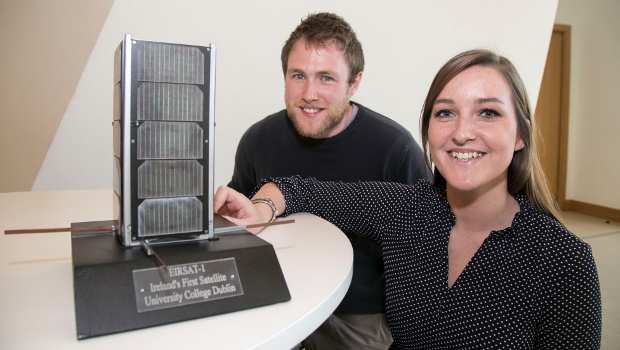Ireland’s first ever satellite, Eirsat-1 has completed the first phase of the European Space Agency’s (ESA’s) Fly your Satellite! (FYS) Programme, the Critical Design Review, and moves one step closer to launch into space.
Eirsat-1 (Educational Irish Research Satellite-1) is a miniature satellite, or CubeSat, and is comparable in size to that of an average shoebox. In May 2017 it was chosen to be part of the second cycle of the FYS! Programme. ESA has concluded that the objectives of the satellite’s Critical Design Review have now been achieved, marking an important milestone for the project.
The UCD team now moves to the next phase of the programme, and will begin to assemble and test an Eirsat-1 prototype in newly installed clean rooms at the University.
Subject to passing further reviews and mission milestones, Eirsat-1 is expected to be delivered to ESA in mid-2020 with three scientific experiments on board. After subsequent launch it is anticipated to operate for a 6-12 month period. Once in orbit the satellite will communicate data to Earth through a ground radio station, located at mission control in the UCD School of Physics.
Prof Lorraine Hanlon, UCD School of Physics and Eirsat-1 project leader, said: “Cubesats such as Eirsat-1 are disrupting the traditional space sector globally, providing a fast and cost effective route to gaining spaceflight heritage. As an emerging space nation, Ireland’s future space endeavours will benefit from the skills developed by the talented team of UCD students who are building Eirsat-1.”
The three Eirsat-1 experiments, designed and developed in UCD, will include technology from industry partners such as ENBIO and SensL (now part of ON Semiconductor).
The main experiment on-board Eirsat-1 will be a novel gamma-ray detector, called GMOD, which aims to detect gamma-ray bursts, the most energetic explosions in the universe, which occur when some stars die or collide.
The second experiment, EMOD, is an in-flight demonstration of thermal control coatings developed by the Irish company ENBIO Ltd.
The third experiment, called Wave-Based Control, or WBC, tests a UCD-developed algorithm to control the movement of Eirsat-1.
The project team includes students from the UCD Schools of Physics; Mechanical & Materials Engineering; Electrical & Electronic Engineering; and Mathematics & Statistics. The students, funded by the Irish Research Council, Science Foundation Ireland and ESA, are being supported by academic staff, postdoctoral researchers, technicians and industry mentors.
Joe Thompson, a PhD student in the UCD School of Mechanical & Materials Engineering, said: “It’s a dream come true for me to work on a project as exciting as Eirsat-1 with amazing people from so many different disciplines and to help make history with them by building and launching Ireland’s first satellite.”
Lana Salmon, a PhD student in the UCD School of Physics, who is leading the ground development element of the project, said: “Students in Ireland, like myself, are for the first time getting the opportunity to contribute to satellite development. I did not expect to be involved in such an exciting Irish project so early in my career. This incredible opportunity has so far provided me with essential hands-on training and links to the Irish space industry, which is of great benefit to my future career.”
TechCentral Reporters






Subscribers 0
Fans 0
Followers 0
Followers